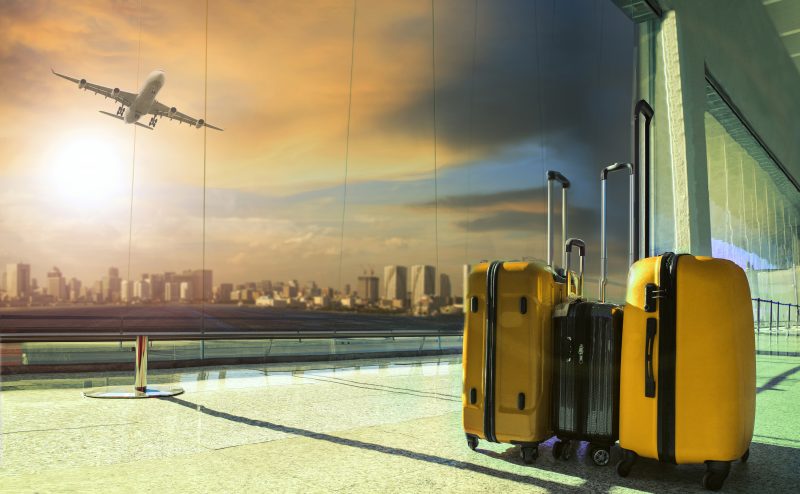All trips, whether you are spending the holidays at home or going on a girl’s weekend to Miami, will require a completely different packing list. Which size of luggage is best?
This luggage size guide will help you understand the dimensions and differences of each size suitcase. There’s a bag for every trip.
What are the Standard Sizes of Luggage?
Your luggage options will likely be limited to the airline standard, even if you travel by train or car. Why? Hand luggage and carry-on luggage must fit in the cabin. Check-in luggage must remain underweight. Stick to flight-approved sizes to ensure your luggage fits for every trip.
You can break down almost all the standard luggage sizes into three categories.
- Hand baggage or personal items: You can store small bags under the seat in front of you.
- Carry-on luggage: Medium-sized bags that fit into the overhead compartments of the plane.
- Checked luggage: Large bags that can be checked before you fly to be stored in the cargo area.
Each airline sets its own standards for size. But nowadays they are generally the same size. It’s best to have at least one of each type if you want to be a smart traveler. This will allow you to pack for every trip like a professional.
Hand Luggage or Personal Items
Hand luggage can be described as a combination of a purse or a suitcase. You can store in it everything you need on your trip, including your phones and other personal items. Handbags must fit under a plane’s seats so that they can travel with you inside the plane.
Size Standards
You don’t need to worry about the size limit if you bring a small purse. If you want to maximize your luggage space, you will need to know the dimensions of your hand luggage.
Personal items on domestic flights can be anywhere from 17x10x9 to 18x14x8 inches. Although you may be able to stuff a bigger backpack under the seat in front of you, it is best to keep the contents within this range.
Personal Items & Hand Luggage
Personal items are meant to be able to withstand traveling. This includes bags and cases that hold or protect your belongings such as:
- Larger purses
- Satchels
- Laptop bags
- Briefcases
- Small backpacks
- Mini duffels or totes
Keep in mind that the term “personal item” can be used to refer to a wide range of items on airplanes. An umbrella, coat, or furry friend might be considered personal items. Make sure to account for airline policies when choosing your luggage.
Benefits and Uses
These are some of the benefits of traveling with your favorite bag.
- Hand-held items – Everyone needs to have their essentials on road trips or flights (passport, phone, headphones, etc.). These items can be easily accessed by a large handbag. It’s essential for trips that last more than an hour.
- Protection – You don’t want your valuables to be lost. Keep your valuables safe in your hand luggage. They will be with you (and within your sight) throughout your trip.
No cost space – Who would trade free cargo space? Every inch is important when flying on a budget. This extra space could save you money and/or give you peace of mind.
Carry-On Luggage

Carry-on bags are the perfect middle, not too large and not too small.
Cabin luggage (or carry-on) is spacious enough to take on a weekend getaway or for a midweek business trip. No need to check bags. They can be used to extend your packing space on longer trips. Combining a checked bag with your suitcase will make it easy to travel on any continental tour.
Size Standards
Airlines also have standard sizes for carry-on bags, just like hand luggage. There are many mid-size options but usually, they are relatively similar in size.
It would definitely simplify our lives, but there is no standard-size suitcase for cabin baggage. Each airline has its own dimensions, which range from 22x14x9 to 24x16x10 inches. Make sure your bag is small enough to be used across multiple airlines. This will ensure that your bag fits into the overhead bin and is not stopped at the check-in.
Carry On Examples
A carry-on bag can be anything from a duffel to a hiking pack. It should fit in the plane’s cabin space, regardless of whether it is under-seat or overhead. Avoid bags with no structure or zip sliders as you don’t want your items to fall out or get damaged.
These common carry-on bags will maximize your space and keep you within the size limit.
- Duffel Bags
- Roller Suitcases
- Larger Backpacks
- Roller Backpacks
- Zipper Totes
Benefits and Uses
Your cabin luggage should be versatile. Your carry-on luggage can free you of baggage fees and offer extra packing space. It also makes it easy to access your belongings.
- Lightweight bags for short trips – Are you planning a long weekend getaway? What about a short Thanksgiving trip home? The perfect bag for this purpose is a carry-on bag. It has enough space to hold all of your essentials and enough outfits for a whole weekend.
- No checked baggage. Checking your bags is a great way to save time and avoid having to carry heavy luggage. And then there is the baggage claim. You can avoid the baggage carousel stress after a flight, or worse, finding your bag missing from the plane.
- Extra packing space If your ticket is eligible for a carry-on bag you can use it as extra luggage space, at no cost to you. You don’t necessarily need to have a checked bag. Take advantage of the packing space. Even if you do have to pay a carry-on fee, you will save at least a few bucks over having your bag checked.
- Backup items – Once you’re onboard, it’s all guesswork. You may feel hungry, thirsty, or cold. A carry-on is your best friend if your personal items aren’t enough. You can keep your eye mask or cozy sweater close by, by packing them in your cabin luggage.
Checked Luggage

Have you ever dreamed of a month-long vacation in Paris? Well, you will probably need at least three to four outfits, right? This is where your checked luggage bag comes into play.
Sizing
Sizes of checked bags are less about maximums than minimums. When a suitcase exceeds the dimensions of cabin luggage (around 24x16x10 in), it is considered checked luggage.
How big can a checked bag get? Some airlines have almost no limits. Others may have a maximum length limit of 62 inches. There are no universally accepted dimensions for checked bags, but here are some examples of sizes and packing capacities.
- Small, checked bag 24x17x10.5inches; perfect for 4- to 7-day trips
- Medium-sized checked bag, 27×18.5x14inches; perfect for 7-10 day trips
- Large, checked bag 32x22x14x in; perfect for 7- to 14-day trips
Remember that airlines often have a maximum weight limit for checked bags. This means you should start packing the heaviest items first and then build up from there.
Checked Luggage Examples
You need to have larger luggage that is both organized and mobile. You might end up dragging your luggage across airport floors. Look for suitcases and luggage bags that have some of these features:
- Roller-wheels
- Large shoulder straps
- Outer zipper compartments
- Inner mesh compartments (for delicate belongings)
- Material that is durable and lightweight (plastic, polyester canvas, etc.)
Benefits and Uses
Why check checked luggage? Space, space, and more space.
A checked suitcase is the best option for those who travel by car, plane, or train. To maximize space in larger bags, you will need to learn how efficiently to pack a suitcase. You might need to pack more luggage for long trips. A checked bag is a great option for people who don’t like feeling heavy while traveling. You won’t have to carry your luggage around the airport.
The right size suitcase is essential for any trip, no matter how short or long. Keep a variety of sizes handy to make travel easy. Every suitcase has its destination, from tiny satchels to roller duffels.
Read more Travel Tips here.






